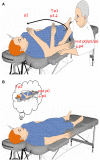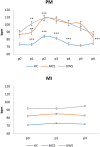Novel Approaches to the Diagnosis of Chronic Disorders of Consciousness: Detecting Peripersonal Space by Using Ultrasonics
- PMID: 29459847
- PMCID: PMC5807342
- DOI: 10.3389/fneur.2018.00047
Novel Approaches to the Diagnosis of Chronic Disorders of Consciousness: Detecting Peripersonal Space by Using Ultrasonics
Abstract
The assessment of behavioral responsiveness in patients suffering from chronic disorders of consciousness (DoC), including Unresponsive Wakefulness Syndrome (UWS) and Minimally Conscious State (MCS), is challenging. Even if a patient is unresponsive, he/she may be covertly aware in reason of a cognitive-motor dissociation, i.e., a preservation of cognitive functions despite a solely reflexive behavioral responsiveness. The approach of an external stimulus to the peripersonal space (PPS) modifies some biological measures (e.g., hand-blink reflex amplitude) to the purpose of defensive responses from threats. Such modulation depends on a top-down control of subcortical neural circuits, which can be explored through changes in cerebral blood flow velocity (CBFV), using functional transcranial Doppler (fTCD) and, thus, gaining useful, indirect information on brain connectivity. These data may be used for the DoC differential diagnosis. We evaluated the changes in CBFV by measuring the pulsatility index (PI) in 21 patients with DoC (10 patients with MCS and 11 with UWS) and 25 healthy controls (HC) during a passive movement and motor imagery (MI) task in which the hand of the subject approached and, then, moved away from the subject's face. In the passive movement task, the PI increased progressively in the HCs when the hand was moved toward the face and, then, it decreased when the hand was removed from the face. The PI increased when the hand was moved toward the face in patients with DoC, but then, it remained high when the hand was removed from the face and up to 30 s after the end of the movement in the patients with MCS (both MCS+ and MCS-) and 1 min in those with UWS, thus differentiating between patients with MCS and UWS. In the MI task, all the HCs, three out of four patients with MCS+, and one out of six patients with MCS- showed an increase-decrease PI change, whereas the remaining patients with MCS and all the patients with UWS showed no PI changes. Even though there is the possibility that our findings will not be replicated in all patients with DoC, we propose fTCD as a rapid and very easy tool to differentiate between patients with MCS and UWS, by identifying residual top-down modulation processes from higher-order cortical areas to sensory-motor integration networks related to the PPS, when using passive movement tasks.
Keywords: cerebral blood flow; chronic disorders of consciousness; motor imagery; peripersonal space; transcranial ultrasound.
Figures







Similar articles
-
Detecting peripersonal space: The promising role of ultrasonics.Brain Behav. 2018 Sep;8(9):e01085. doi: 10.1002/brb3.1085. Epub 2018 Aug 9. Brain Behav. 2018. PMID: 30094963 Free PMC article.
-
Peri-Personal Space Tracing by Hand-Blink Reflex Modulation in Patients with Chronic Disorders of Consciousness.Sci Rep. 2020 Feb 3;10(1):1712. doi: 10.1038/s41598-020-58625-z. Sci Rep. 2020. PMID: 32015445 Free PMC article.
-
An action-observation/motor-imagery based approach to differentiate disorders of consciousness: what is beneath the tip of the iceberg?Restor Neurol Neurosci. 2021;39(3):181-197. doi: 10.3233/RNN-201130. Restor Neurol Neurosci. 2021. PMID: 33998559
-
A Systematic Review of Sleep in Patients with Disorders of Consciousness: From Diagnosis to Prognosis.Brain Sci. 2021 Aug 16;11(8):1072. doi: 10.3390/brainsci11081072. Brain Sci. 2021. PMID: 34439690 Free PMC article. Review.
-
EEG-based Brain-Computer Interfaces for people with Disorders of Consciousness: Features and applications. A systematic review.Front Hum Neurosci. 2022 Dec 5;16:1040816. doi: 10.3389/fnhum.2022.1040816. eCollection 2022. Front Hum Neurosci. 2022. PMID: 36545350 Free PMC article.
Cited by
-
Virtual Reality Based Cognitive Rehabilitation in Minimally Conscious State: A Case Report with EEG Findings and Systematic Literature Review.Brain Sci. 2020 Jul 1;10(7):414. doi: 10.3390/brainsci10070414. Brain Sci. 2020. PMID: 32630179 Free PMC article. Review.
-
Functional Connectivity of Anterior Insula Predicts Recovery of Patients With Disorders of Consciousness.Front Neurol. 2018 Nov 30;9:1024. doi: 10.3389/fneur.2018.01024. eCollection 2018. Front Neurol. 2018. PMID: 30555407 Free PMC article.
-
Detecting peripersonal space: The promising role of ultrasonics.Brain Behav. 2018 Sep;8(9):e01085. doi: 10.1002/brb3.1085. Epub 2018 Aug 9. Brain Behav. 2018. PMID: 30094963 Free PMC article.
-
Toward understanding the neurophysiological basis of peripersonal space: An EEG study on healthy individuals.PLoS One. 2019 Jun 24;14(6):e0218675. doi: 10.1371/journal.pone.0218675. eCollection 2019. PLoS One. 2019. PMID: 31233542 Free PMC article.
-
Neural coding of autonomic functions in different states of consciousness.J Neuroeng Rehabil. 2023 Jul 26;20(1):96. doi: 10.1186/s12984-023-01216-6. J Neuroeng Rehabil. 2023. PMID: 37491259 Free PMC article.
References
LinkOut - more resources
Full Text Sources
Other Literature Sources
Research Materials
Miscellaneous

